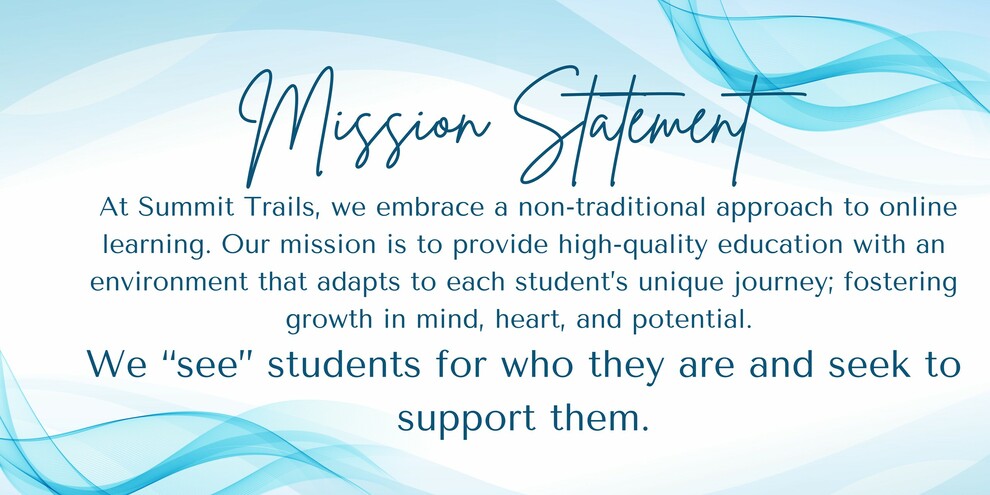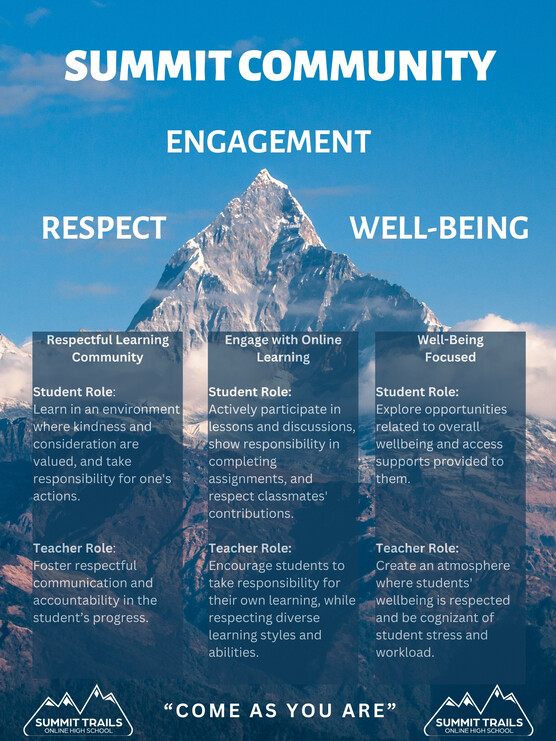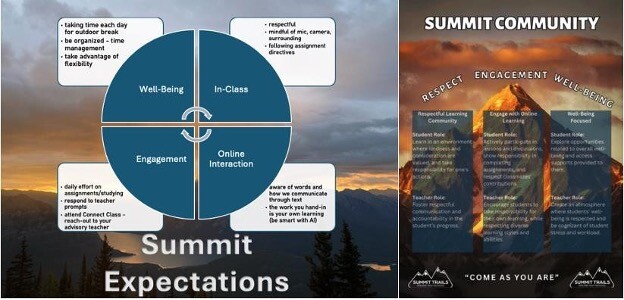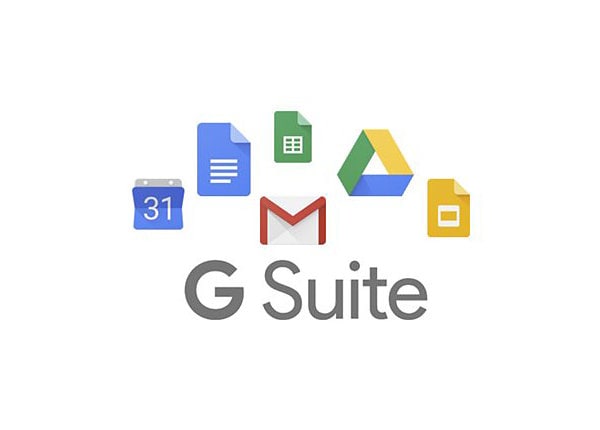
What is Online Learning at Summit?

This is an important question to ask. There has been a good body of research on the success rate of online education. "Online education has been seen as a game changer for learner" (Micheal Barbour).
The Summit Trails l serves students from grades 10-12. Our courses are both synchronous and asynchronous. Students will attend live online sessions with their teacher and have ample time to complete their work. However, online courses typically take students longer to accomplish. Therefore, we will consider organizing courses not to overwhelm the user and allow students to work ahead if needed.
Our staff is comprised of 8 synchronous teachers and 7.5 WeConnect Asynchronous teachers. As our enrolment increases, so will our teacher count and course offerings.
The bell schedule allows teenagers to enter into learning when the brain is best ready. Research suggests this time ideally is at 9:30 am. Therefore, our program starts at 9:30 am with Connect class on Wednesdays, first class at 10:00 am, and ends at 2:30 pm for classes, allowing students to use the remainder of the day to accomplish the learning objectives.
Since our teachers operate online, we will utilize the CLASS ZOOM platform combined with classroom tools such as Turn-it-in, Moodle, SmarterMarks, Poodl, Koha, Discovery Education and more.
An online classroom uses webcasting interactions to learn the course material. They interact with their teachers and classmates through live digital means. Completing the course work occurs on a digital platform. Moodle is the platform used for Summit Trails. Course design is either synchronous or asynchronous. Synchronous means the student attends online classes and completes their work with due dates. Asynchronous is student-directed with a teacher overseer. The student does not attend classes.
School Matrix on Expectations

Do students have class every day?
Yes and no, students will have lessons throughout the week simultaneously every day. On days when there are no direct lessons, the teacher is available in their Zoom room for support. Many students will attend every day and find great success because they can connect with the teacher. Online schooling takes more time for students because they need to read more and interact with the Moodle platform. In addition, students need time to complete their work.
Do students turn on their cameras during learning?
Yes, we ask students to turn on their camera and or interact with the lesson by answering questions or making comments. We use the Class software, where students can hide their screens from other students. Teachers need to see student faces to know if what they are teaching is "landing" with the student. We understand some students find this difficult. We hope that students will become comfortable with their cameras over time. Teachers use observation as a means of assessment in class.
Scheduling
All scheduling is completed through our Guidance Counsellor. If you would like to book a time to organize schedules or discuss counselling, click here.
What should students be aware of before they start online education?
We have two types of courses: synchronous (with a teacher-class pace) and asynchronous (student pace-not direct teaching).
Attributes of Synchronous
- Students attends 2-5 classes a week for direct teaching and group work
- Student can access anywhere
- Students follow a class model of learning to assist with completing assignments daily.
- Student uses their computer and other technological means to complete work
- Students use the Moodle Platform as the learning management system.
- Student has greater responsibility for daily tasks and the organization of work
- Student has greater flexibility with their time
- Student can focus on subject matter as they see the need, for example: Class on Monday and on Tuesday they can work 30 minutes or 60 minutes on the task. The student can move at their related speed for completion.
- Teacher meets with students during the week for group and one-on-one assistance
- The completion of the course is within the students control. In High School, if the course is not completed, the student will not receive the credit and will need to either retake the course or take a different level of the course.
- Expect the teacher to ask you to turn on your camera and participate in classes.
Asynchronous Courses
- the course is completely contained online
- The student must organize their time to complete the course tasks within a reasonable time.
- The student can move at their own pace to complete the course
- The course has a teacher who can assist the student as needed. The teacher is virtual, however the teacher does not provide direct instruction.
- The student has flexibility in their day to focus on classes based upon need and interest.
Micro Credits
Students can now take up to 8+ credits, including some at the 30 level, at their own pace. Choose from Wildlife, Buying and Selling Cars, and 3 Health and Wellness courses to earn extra credits towards graduation. All courses are self-directed, so there is no need to register. Sign in to Moodle and self-enroll to get started.
All of the above attributes can either work "for" a student or "against" them. Here are factors you should consider before enrolling in virtual education.
- Isolation can be an issue for some students.
- What plan does the student have to make sure they are connecting with peers?
- Organization - for students who struggle with self-regulation will need parental support to organize their day.
- Visual organizers with timers to remind them to switch. Remember most students are coming off of an in-person school with bells to tell their brain to switch.
- Spending too much time on a topic - sometimes students spend too long on a task, not realizing they need to either ask for help from their teacher, or switch to another task.
- Set up and understanding that after working on topic for "x" long, switch to something different and then come back. Some topics will take longer to complete based on their interest and ability. For instance, writing an essay may take longer than completing a math question based on the students ability to either of those areas.
- Motivation - the "why" is important. If a student is motivated to complete and have success in a class, they will engage in the learning. If the student is avoiding education, they will find it difficult to do the work in a timely manner and or engage in synchronous classes.
- By far this is the most important discussion to have as a family. The why will motivate or be a stumbling block.
- Life in one room - if the student is using their bedroom for their learning, they end up spending their days in the room, and then their nights as well.
- Variety is important in one's life. Build in times during the day the student is leaving their space to work or doing another act which is physical in nature (exercise, Yoga and more).
What about textbooks?
Your Moodle Course is the text book. Everything you need for the course is in the Moodle Course.
How Do Field Trips Work?
This year is an anomaly for trips. Many of the places we would be visiting are part of the PEC Alberta programming or have restrictions which would prevent us being inclusive. Therefore we can not participate. However, as opportunities open up, teachers will provide different ways students can engage with field trips.
Transportation: Any trip we offer the parents are to drop the student off at the location and pick them up.
Athletics
Summit Trails does not have an athletics program. However, students can try out for sports teams at schools where they would be designated for in-person learning. All RVS High Schools are willing to allow Summit Trails students participate in tryouts. It is the responsibility of the student to connect with the school for tryout times etc.
What technologies do we utilize?
|
|
Read&Write for Google Chrome |
Assists students by reading the material, spell checking, highlighting pages, text to speech, speech to text, reader reduction, and more. |
|---|---|---|
 |
Moodle |
Learning Management System for all classes |
 |
SmarterMarks | Test Taking system used buy math and science |
 |
RVS Google Suite | Robust features from Google once the student signs in with their RVS Google Email. |
|
|
Screen Shot Reader | Allows students to have the computer read anything on a web page easily. Chrome Extensions |
 |
Carnegie Learning | This resource is used for our French Classes. Interactive French classroom. |
 |
Marigold Systems | Public Library System for digital access to many supports. |
 |
Turnitin | Google Add-for submitting written assignments and grammar check |
